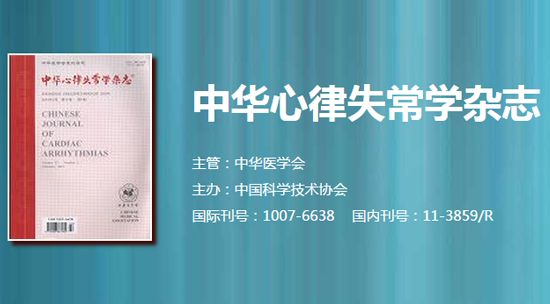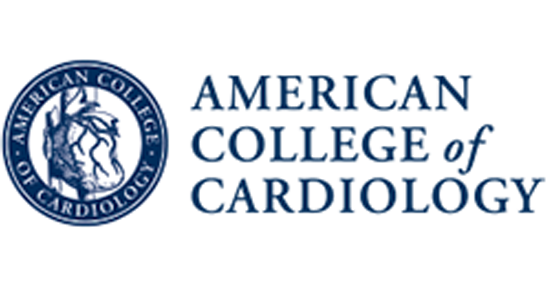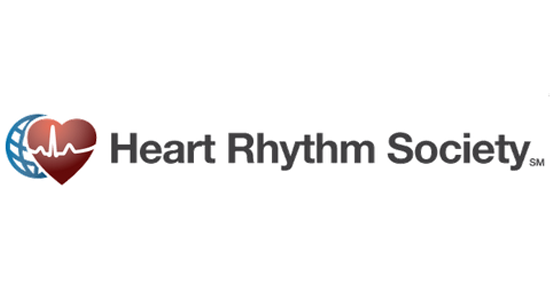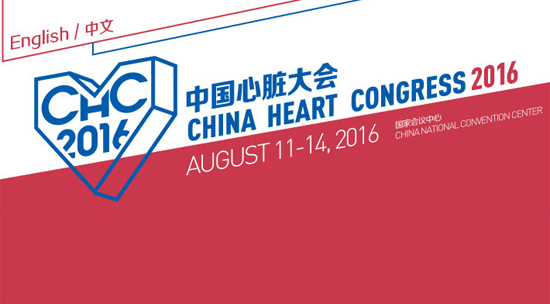HeartRhythm主编—陈鹏生教授语音速递(三月刊 英文版)
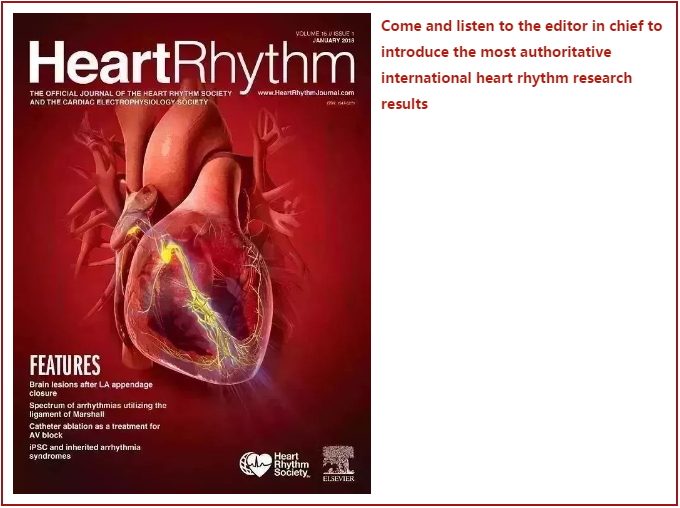

Peng-Sheng Chen
The first original article is titled “Relationship between Device-detected Burden and Duration of Atrial Fibrillation and Risk of Ischemic Stroke”. The authors studied 384 patients with a cardiac implantable device and an atrial lead. After a mean of 3.2 years of follow up, the incidence of stroke/TIA of 14.8%, or 4.6% per year. The burden of AF and the duration of longest episode demonstrated a significant positive correlation to each other but not CHA2DS2- VASc score. Importantly, although the CHA2DS2-VASc score was predictive of stroke/TIA, neither burden nor duration was associated with stroke/TIA. These data suggest that among patients with CIED-detected AF, once AF occurs, stroke risk seems to be predominantly driven by underlying risk factors and not by the amount of AF measured by either burden or duration.
The next one is titled “Epicardial Course of the Septopulmonary Bundle: Anatomical Considerations and Clinical Implications for Roof Line Completion.” One hundred consecutive patients underwent AF ablation. A de novo roof line was created between the superior pulmonary veins. In cases of residual gaps, a floor line was created between the inferior pulmonary veins. In addition, microtomography imaging and histological analyses of 5 human donor hearts were performed. The authors found that the epicardial conduction across the roof line is common and requires careful electrogram analysis to detect. In such cases, a floor line can be an effective alternative strategy, with clear validation criteria. Myocardial thickness and fat interposition may explain difficulties in achieving lesion transmurality during roof line ablation.
Coming up next is “Active compression versus standard anterior-posterior defibrillation for external cardioversion of atrial fibrillation. A prospective randomized study”. The purpose of this study was to assess the efficacy of applying active compression on defibrillation electrodes during AF cardioversion. The authors performed a bicenter randomized study including patients referred for persistent AF cardioversion. Patients were randomly assigned to standard anterior-posterior defibrillation or to defibrillation with active compression applied over the anterior electrode. The authors found that active compression applied to the anterior defibrillation electrode is more effective for persistent AF cardioversion than standard anteriorposterior cardioversion, with lower defibrillation threshold and higher success rate.
Next up is “Predictive value of atrial fibrillation during the post radiofrequency ablation blanking period.” The current consensus statement recommends the use of a “blanking period” of 3 months after the procedure, during which reintervention should be avoided in patients with AF recurrence. The authors performed a systematic literature review and meta-analysis to determine the predictive value of the absence of recurrence in the blanking period. For paroxysmal AF, 89% of patients free from early recurrence remained free from late recurrence. The estimate for persistent AF was similar at 91%. The authors conclude that freedom from AF recurrence during the blanking period is highly predictive of longer-term success in catheter ablation. Clinical trials in this area may be able to leverage these findings to more quickly assess the potential utility of new ablation technologies and methods, for example, by using early surrogate measures of success.
The next article is titled “Prognostic value of Implantable Defibrillator-computed Respiratory Disturbance Index: the DASAP-HF study”. The Diagnosis and Treatment of Sleep Apnea in Patient With Heart Failure, or DASAP-HF study previously demonstrated that the respiratory disturbance index (RDI) computed by the ApneaScan algorithm accurately identifies severe sleep apnea in ICD patients with heart failure. The authors assessed the incidence of clinical events after 24 months and investigate the association with RDI values. The RDI calculated at 1 month after implantation was used to stratify patients (below or above 30 episodes/h). The endpoints were all-cause death and a combination of all-cause death or cardiovascular hospitalization. Among the 265 enrolled patients, 224 had usable RDI values. After 2 years of follow up, the authors found that in heart failure patients implanted with an ICD, higher RDI values are associated with death and cardiovascular hospitalizations. Devicedetected severe sleep apnea independently predicts death.
Up next is “Subcutaneous versus Transvenous Implantable Defibrillator: an updated Metaanalysis.” The purpose of this study was to conduct an updated meta-analysis comparing SICD vs transvenous or TV-ICD. Thirteen studies comprising 9073 patients were included in the analysis. There was no statistically significant difference in the risk of the primary outcome between S-ICD and TV-ICD. Patients with S-ICD had lower risk of lead complications and major procedural complications but higher risk of pocket complications compared to those with TVICD. No significant differences were found for the other outcomes. The authors conclude that in patients with an indication for ICD without the need for pacing, TV-ICD and S-ICD are overall comparable in terms of the composite of clinically relevant device-related complications and inappropriate shock.
Coming up next is “Percutaneous Management of Superior Vena Cava Syndrome in Patients with Cardiovascular Implantable Electronic Devices”. The authors report their experience with transvenous lead extractions in the setting of symptomatic CIED-related SVC syndrome. Over a 14-year period, more than 1600 transvenous lead extractions were performed in a high volume center. Of these, 16 patients underwent the procedure for symptomatic SVC syndrome. After extraction, 6 patients (37.5%) received an SVC stent. Balloon angioplasty was performed before stenting in 5 cases (31.3%). There was 1 major complication (6.3%) due to an SVC tear that was managed surgically with a favorable outcome. Eleven patients underwent reimplantation of a CIED. Over a median follow-up of 5.5 years, 12 patients (75%) remained free of symptoms. The authors conclude that combining transvenous lead extractions with the percutaneous treatment of symptomatic SVC syndrome is a safe and viable treatment strategy.
The next one is titled “Reassessing the role of Antitachycardia Pacing in Fast Ventricular Arrhythmias in Primary Prevention ICD Recipients: Results from MADIT-RIT”. The purpose of this study was to assess the value of antitachycardia pacing (ATP) for fast ventricular arrhythmias ≥ 200 beats/min in patients with primary prevention ICD. The patients were randomized to arms A, B and C with the time delay between VT detection and therapy of 3.4 vs 4.9 vs 14.4 seconds. The final shock rate was similar in arm A vs arm B and in arm A vs arm C despite the marked discrepancy in initial ATP therapy utilization. The authors conclude that in MADIT-RIT, there was a significant reduction in ATP interventions with therapy delays due to spontaneous termination, with no difference in shock therapies. These data suggest that earlier interventions for fast ventricular arrhythmias are likely unnecessary. The value of ATP in primary prevention ICD recipients may be overestimated.
The following article is “Sex-Differences in Arrhythmic Burden with the Wearable Cardioverter Defibrillator”. The authors studied the wearable ICD or in the WEARIT-II Registry. There were 598 women and 1402 men. The authors found that there is a higher burden of ventricular and atrial arrhythmic events in women than in men. ICD implantation rates at the end of the Wearable Cardioverter Defibrillator use were similar. These findings warrant monitoring women at risk for sudden cardiac death who have a high burden of atrial and ventricular arrhythmias while using the Wearable Cardioverter Defibrillator.
Up next is “Mortality after cardioverter-defibrillator replacement: results of the DECODE SUrvival SCore Index”. DECODE was a prospective, single-arm, multicenter cohort study of 983 patients who underwent ICD and CRT-D replacement. During a median follow-up period of 761 days, 114 patients (12%) died. In multivariate Cox regression analysis, New York Heart Association class III/IV, ischemic cardiomyopathy, body mass index < 26 kg/m2, insulin administration, age ≥ 75 years, history of atrial fibrillation, and hospitalization within 30 days before ICD replacement remained associated with death. The authors conclude that a simple score that includes a limited set of variables appears to be predictive of total mortality in an unselected real-world population undergoing ICD replacement. Evaluation of the patient's profile may assist in predicting vulnerability and should prompt individualized options, especially for high-risk patients.
The next article is titled “Intraprocedural dynamics of cardiac conduction during transcatheter aortic valve implantation - assessment by simultaneous electrophysiology testing”. The purpose of this study was to characterize the impact of transcatheter aortic valve implantation (TAVI) on the conduction system as assessed by simultaneous EP testing. The authors found that between baseline and implantation of the valve prosthesis, there were significant increases of HV interval and QRS duration but no increase of AH interval. Implantation depth positively correlated with QRS prolongation but not with changes of AH or HV interval. The authors conclude that electrophysiological testing during TAVI shows impairment of infranodal AV conduction by balloon predilation and valve implantation. This impairment is positively correlated with valve implantation depth and results in an increase of QRS duration with mainly LBBB pattern on surface electrocardiogram.
Coming up is “Identification of important risk factors for all-cause mortality of acquired long QT syndrome patients using random survival forests and non-negative matrix factorization”. The purpose of this study was to examine the important predictors of all-cause mortality of acquired LQTS patients by applying both random survival forest and non-negative matrix factorization analyses. A total of 327 acquired LQTS patients were included. The authors found that cancer and serum potassium and calcium levels can predict all-cause mortality of acquired LQTS patients, as can ECG indicators including JTc interval and QRS duration. The use of random survival forest and non-negative matrix factorization analyses significantly improved mortality prediction.
The next paper is “Three-dimensional guided selective right ventricular septal pacing preserves ventricular systolic function and synchrony in pediatric patients”. Nonfluoroscopic 3-dimensional (3D) electroanatomic mapping systems (EAMs) have been developed to guide cardiac catheter navigation and reduce fluoroscopy. The authors performed prospective analysis of children/adolescents who underwent EAM-guided selective RV pacing. Thirty-two complete AV block patients underwent selective RV septal pacing with narrow paced QRS and low radiation exposure. Follow-up over 24 months showed preserved LV function and synchrony. The authors conclude that EAM-guided selective RV septal pacing is a feasible technique associated with preserved LV systolic function and synchrony and low radiation exposure in pediatric patients with complete AV block.
Coming up is “Impact of Myocardial Fiber Orientation on Lesions Created by a Novel Heated Saline Enhanced Radiofrequency Needle-tip Catheter: An MRI Lesion Validation Study”. Eleven dogs underwent catheter ablation using a heated saline-enhanced radiofrequency (SERF) needle-tip catheter system. Forty-three of 57 lesions (75.4%) were transmural, and lesion depth reached approximately 90% of LV wall thickness. Lesion volume showed a positive linear correlation with power × radiofrequency time index. Maximum width and maximum length of all lesions were distributed in the middle layer of LV where myocardium runs circumferentially. The authors conclude that this catheter showed feasibility in creating transmural LV lesions. More importantly, SERF lesions extended along the myocardial fiber orientation.
The following article is “Repeated exposure to transient obstructive sleep apnea related conditions causes an atrial fibrillation substrate in a chronic rat model.” The transient OSA conditions were simulated by intermittent negative upper airway pressure, which was applied in sedated spontaneously breathing rats to simulate mild-to-moderate OSA. The authors found that acute simulation of OSA was associated with reversible atrial oxidative stress. Cumulative exposure to these transient OSA-related conditions resulted in AF substrates and was associated with increased AF susceptibility. The authors propose that mild-to-moderate OSA with high night-to-night variability may deserve intensive management to prevent atrial substrate development.
Next up is a paper titled “The frequency spectrum of sympathetic nerve activity and arrhythmogenicity in ambulatory dogs”. The authors used radiotransmitters to record stellate ganglion nerve activity, subcutaneous nerve activity, heart rate and blood pressure in 6 ambulatory dogs. They found high, low and very low frequency oscillations of the nerve activity. The high frequency oscillations in blood pressure and heart rate correlate with high frequency oscillations in sympathetic nerve activity and are present at all time. High frequency oscillations can be overshadowed by the much larger low frequency and very low frequency burst activities. Paroxysmal atrial tachycardias occur only in time windows where low and very low frequencies were the dominant frequency. In addition, the frequency spectra determined in the subcutaneous nerve activity reflect that in the stellate ganglion nerve activity.
These above original articles are followed by a contemporary review titled“Cybersecurity: the need for data and patient safety with cardiac implantable electronic devices”. Dr Guenter Breithardt wrote a Viewpoint titled “The dawn of radiofrequency catheter ablation for cardiac arrhythmias” as the 3rd entry in our series of articles to celebrate the 30th year of RF ablation. Dr Barry Maron wrote a Viewpoint article titled “The 'Guidant Affair': 15 Years Later”. That paper is followed by a historical vignette article titled “Celebrating 50-years of the Lithium Power Source for Cardiac Pacemakers”, written by Dr Harry Mond.
I hope you enjoyed this podcast. For Heart Rhythm, I’m Editor-in-Chief, Dr. Peng-Sheng Chen.
